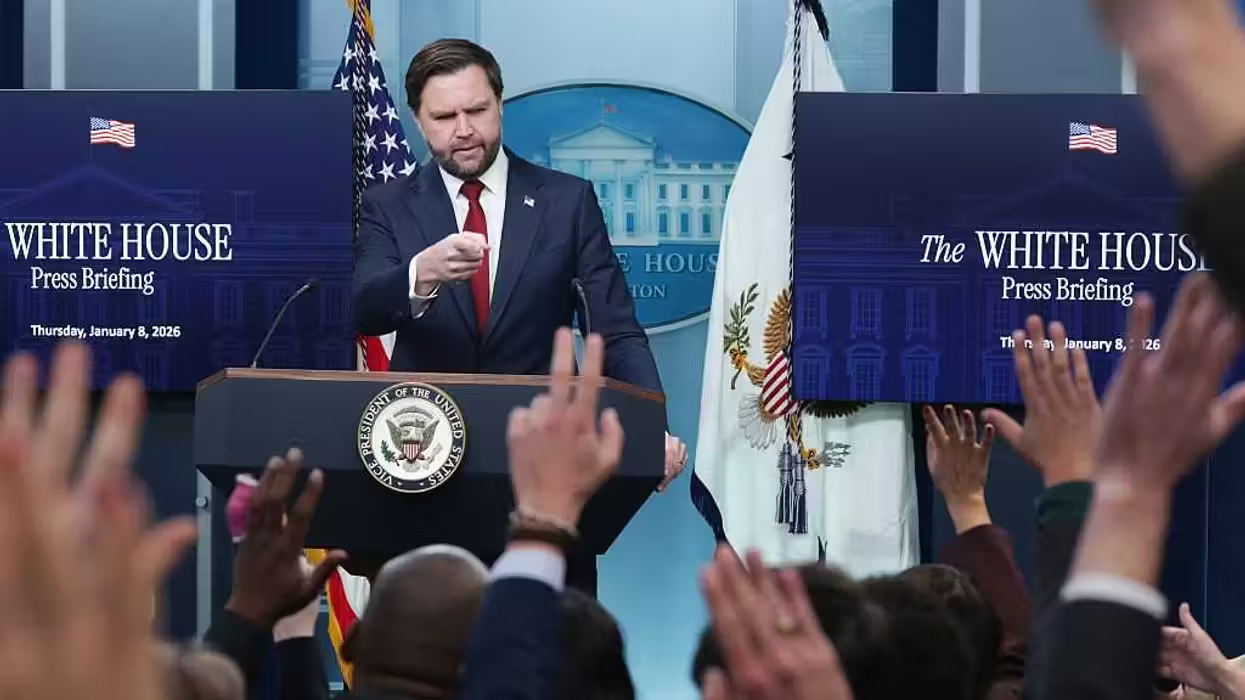
© 2026 Blaze Media LLC. All rights reserved.
The Florida senator on everything from immigration to marriage.
Marco Rubio is out with a new book, "American Dreams: Restoring Economic Opportunity for Everyone," that figures to be an opening salvo to a 2016 presidential run.
We picked out some of the more prominent themes/programs from "American Dreams" for your reading pleasure -- taken directly from the senator's book -- which you can find below.
 Sen. Marco Rubio, R-Fla., speaks at the Faith and Freedom Coalition Road to Majority Conference in Washington, Thursday, June 13, 2013. (Credit: AP)
Sen. Marco Rubio, R-Fla., speaks at the Faith and Freedom Coalition Road to Majority Conference in Washington, Thursday, June 13, 2013. (Credit: AP)
1) Elizabeth Warren Populism
My Senate colleague and liberal populist hero Elizabeth Warren had a point when she told a MoveOn.org audience last year that "the game right now in America is rigged. It is rigged so that those at the top keep doing better and better, and everyone else is under increasing pressure, is under increasing economic strain. The rules don't get better for America's middle class. The rules are getting better for those who are a thin slice at the top." As I said, Senator Warren had a point--it just wasn't the point she thought she was making. It is government that is increasingly rigging the game against the working and middle classes.
...To "unrig the game," as Senator Warren might put it, we need less investment in government and more investment in America. We need to reward innovation, not political access. Most of all, we need a level playing field for U.S. businesses, large and small.
[sharequote align="center"]"We need to reward innovation, not political access"[/sharequote]
2) The Plan for Illegal Immigrants
First, those here illegally must come forward and be registered. If they have committed serious crimes or have not been here long enough, they will have to leave. With the new E-Verify system in place, they are going to find it difficult to find a job in any case.
Second, those who qualify would be allowed to apply for a temporary nonimmigrant visa. To obtain it they will have to pay an application fee and a fine, undergo a background check and learn English. Once they receive this work permit, they would be allowed to work legally and travel. To keep it, they will have to pay taxes. They would not qualify for government programs like Obamacare, welfare or food stamps. And if they commit a crime while in this status, they would lose their permit.
Third and finally, those who qualify for a nonimmigrant visa will have to remain in this status for at least a decade. After that, they would be allowed to apply for permanent residency if they so choose. Many who qualify for this status will choose to remain in it indefinitely. But those who choose to seek permanent residency would have to do it the way anyone else would, not through any special pathway.
3) The "most fundamental change to how America fights poverty and encourages income mobility since President Johnson"
First, give the states real freedom to create innovative programs to encourage work among the poor. Second, improve the current federal wage subsidy to keep them working.
[instory-book ISBN="9781595231130"]
...The [first] idea is to take the hundreds of billions of dollars' worth of federal antipoverty funds and consolidate them into something I call a "Flex Fund." The Flex Fund would be just what it sounds like: a fund that distributes a lump sum payment to the states to use to support or create innovative and multifaceted state and local antipoverty programs.
...The animating principle behind the Flex Fund is this: Government has an important role to play in helping the poor, but it should be the government that's closest to the people it's trying to help.
...[R]evitalized state poverty programs under the Flex Fund will work hand in hand with a new federal wage enhancement tax credit to encourage and reward work. The philosophy behind the federal wage Enhancement Credit is summed up very nicely by Robert Doar, who was in charge of implementing welfare reform for New York City between 2007 and 2013. One of the things he learned, Doar says, is "making work pay is welfare reform too."
...Under the law, welfare recipients had to be working or looking for work in order to receive benefits. According to Doar, when it came to getting off welfare, nothing substituted for a job--not education, not training. New Yorkers who were quickly employed stayed employed longer. Work participation rates rose faster than even the most enthusiastic welfare reform advocates had anticipated--even among never married single moms.
...I have proposed that we build on the success of the EITC [Earned Income Tax Credit] by substituting it with the Wage Enhancement Credit for low-income workers. Under my plan, workers making less than $20,000 would receive a monthly 30 percent credit from the government. This would allow an unemployed individual to take a job that pays, say, $18,000 a year--which on its own is not enough to make ends meet--but then receive a wage enhancement to make the job a better alternative to collecting unemployment insurance. This wage enhancement would gradually diminish up to a yearly income of $40,000.
Unlike the EITC, which delivers the wage subsidy in a once yearly lump sum, the Wage Enhancement Credit would be delivered monthly through a check from the Treasury. So instead of blowing the money on year-end vacations or flat-screen TVs, the money is more likely to be used for monthly living expenditures or even saved. Moreover, the wage enhancement would function like an increased minimum wage but with a critical difference: It would increase available jobs rather than decrease them. Nor would it force employers to pass higher labor costs along to consumers.
4) An Alternative to Student Loans
 Students protest the rising costs of student loans for higher education on Hollywood Boulevard on September 22, 2012 in the Hollywood section of Los Angeles, California. Citing bank bailouts, the protesters called for student debt cancelations. (Credit: David McNew/Getty Images)
Students protest the rising costs of student loans for higher education on Hollywood Boulevard on September 22, 2012 in the Hollywood section of Los Angeles, California. Citing bank bailouts, the protesters called for student debt cancelations. (Credit: David McNew/Getty Images)
What if there was a way to give students the option of paying for their education without acquiring any student debt at all? What if investors assumed the risk that students and their families now bear alone in student loans? What if there were a way to finance your daughter's or son's higher education the way we finance start-up companies--by having others make the investment in their success?
There is a way and here is how it works. Let's say you are a student who needs $10,000 to pay for your last year of school. Instead of going into debt for $10,000, you could apply for a "Student Investment Plan" from a private investment group. These investment groups would pay your $10,000 tuition in return for a predetermined percentage of your income for a set period of time after graduation--maybe 4 percent of your income a year for ten years. At the end of that period, if the amount paid is greater than the investment, the investors make a profit. If it's less, they lose money. Either way, they assume the risk of paying for your education. Unlike with loans, you would be under no legal obligation to pay back that entire $10,000. Your only obligation would be to pay that 4 percent of your income per year for ten years, regardless of whether that ends up amounting to more or less than $10,000.
...Bowie Bonds [as in David Bowie] inspired some financial analysts who had watched promising classmates drop out of school because they couldn't afford to continue. What if students were, in effect, allowed to sell bonds in their future success? The concept has been tried in Europe and Latin America, where it has been a godsend to low-income students in particular...Questions of who would enforce the contracts, and state laws that prohibit the assignment of future income, have held back potential investors. But I believe it's time to take a more creative and innovative approach to paying for higher education.
The Investing in Student Success Act, which I introduced last year, paves the way for a new and less risky way for families to pay for college. The legislation creates investment savings accounts to allowing investment groups, under carefully circumscribed rules to protect students, to invest in students' tuition in exchange for a piece of their postgraduation income. These groups would look at factors such as a student's major, the institution he or she attends and his or her academic record, and then assess the student's likelihood of getting a good job and paying them back.
5) Fixing College Accreditation
Lessening the burden of student debt and finding innovative new ways to pay for college are important, but broad, innovative pathways to higher education for all Americans will not be found until we reform this broken and biased system. It's not rocket science. Free online learning is already a reality. Why couldn't a student, after completing an online course, test into college credit for it? She could pay a small fee to take a standardized test that, if passed, would allow the course to count toward a college degree. We already do this for high school students who take AP courses. They pass a test that allows them to count these courses toward their degrees at most colleges.
To make "testing in" a reality at the college level, Congress could establish a new, independent accrediting board to ensure the quality of these free courses and make the credits transferable into the traditional system. The board would factor in input from the private sector and would allow students to qualify for some type of federal aid to cover any potential costs. By allowing online college courses to go toward a degree, we could create what would virtually amount to a debt-free college education.
6) Towards a Fairer Tax Code
 (Photo: Forbes)
(Photo: Forbes)
The plan Senator [Mike] Lee and I have proposed would restore some semblance of fairness to our tax code for families raising children by recognizing the investment they make. It would simplify the tax code by consolidating the current seven income tax brackets into just two: 15 percent and 35 percent. However, the centerpiece of the plan is a new $2,500 tax credit for each child under sixteen. The current code offers a $1,000 per child tax credit that phases out at higher incomes, as well as a tax deduction for each dependent child, which just reduces the amount of your taxable income. Our new tax credit will actually reduce the amount of taxes owed by $2,500 for each child. The sum of this expanded Child Tax Credit is limited to the total of income and payroll tax liabilities and it is charged after all other tax liabilities and after all other tax credits. This design is intended to offset the payroll tax liability of parents, because payroll taxes finance the entitlement system.
Not only would this plan have the American virtue of treating all taxpayers more equally, it would provide real, immediate relief to middle- and working-class parents. With these reforms, a married couple with two children who make the median national income of $51,000 would get a tax cut of about $5,000 per year. That's not enough to pay for braces and summer camp, but it is a nice offset to the cost of day care to allow a mom to work more hours, or to compensate for lost wages so she can work less.
7) Repealing and Replacing Obamacare
It's not too late to replace it [Obamacare] with reforms that give all Americans the chance to buy the kind of health insurance they want, from any company they choose, at a price they can afford. Wisconsin Representative Paul Ryan and I have proposed a set of modern, market-based health care reforms we believe will do just that.
...The first change is to convert the tax preference for employer-sponsored health care into a tax credit for the individual. The current system allows employers to deduct their share of the cost of their employees' health care as a business expense. It also has employees deduct the cost of their health insurance from their gross income. The result has been to favor employer-provided health care. This third-party payer system, in which the consumer doesn't control his or her own health care, encourages health care consumption and drives up costs. But health care isn't free. The higher costs to employers have resulted in lower wages for employees.
Our tax credit, in contrast, would restore the middle class's ability to both afford and control their own health care. If everyone under sixty-five who is not on Medicaid participated, we could offer a $2,000 credit for an individual plan and a $5,800 credit for a family plan--more than enough to cover the average worker's current out-of-pocket costs. Americans could use the credit to purchase whatever insurance plan they want or deposit it in a Health Savings Account (HSA). What's more, the credit would be refundable--if an individual's health care costs are less than the credit, they get to keep the difference. It would be paid out every month, just like a health care premium. And in an era when the average worker stays at a job for less than five years, it would travel from job to job with the individual.
...[O]ur second reform, such as it is, is to maintain the ability of employers to deduct their health care costs as a business expense. This will ensure that some employers still have an incentive to provide health insurance to their employees. Our plan would phase out the employer health insurance exclusion over ten years, while immediately creating a refundable health care tax credit. This would ensure the creation of a vibrant individual health insurance marketplace while avoiding disruptions to the health insurance plans that people currently receive from their employers.
8) Giving Americans Congress' Retirement Savings Plan
Members of Congress and other federal employees have exclusive access to the Thrift Savings Plan (TSP). Like a traditional employer-sponsored 401(k), the TSP allows federal employees to save pretax money for retirement. But unlike the typical employer-sponsored plan, it charges fees that are a fraction of those charged by most private defined-contribution plans and offers high rates of return. When costs are lower and returns are higher, beneficiaries save more. So the twisted irony is that members of Congress--who are employees of the citizens of the United States--have access to a superior savings plan, while many of their employers--the American people--are often left with access to no plan at all.
The most obvious and most just solution, I believe, is to give Americans who don't have access to an employer-sponsored [retirement savings] plan the option of enrolling in the federal Thrift Savings Plan.
Giving Americans hard at work in the private sector who lack a retirement savings plan the same one that members of Congress enjoy can be done at little cost--the infrastructure is already in place. These private employees wouldn't be offered matching funds, so the only expense involved would be the additional administrative costs of handling the new deposits.
9) Social Security
Some liberals in Congress have proposed that the Social Security payroll tax be raised on working people and their employers in order to expand Social Security benefits for all, regardless of their need. But unlike the income tax, everyone pays payroll tax, regardless of how little you earn. Raising a payroll tax on everyone would be a significant tax increase on millions of Americans who are barely getting by as it is. Therefore, instead of raising taxes (which seems to be the left's solution to every problem), a better approach would be to eliminate the payroll tax altogether for all Americans who have reached retirement age.
...We shouldn't punish them [people over 65] for choosing to keep working rather than immediately cashing in.
Eliminating the payroll tax on workers who have reached retirement age will do several things I dare say liberals would agree with. In addition to removing the disincentive to work, it will help seniors accelerate their savings by letting them keep more of their money...[I]t could also make older workers more attractive to employers, since the employer's half of workers' payroll taxes would also be eliminated. Finally...the elimination of the payroll tax for those past retirement age could be accomplished with little or no effect on Social Security revenues.
...We [also] need to increase the retirement age for future retirees to account for the rise in life expectancy. If we act soon, we can do this without changing the retirement age for people who are currently over the age of fifty-five.
...[Lastly] [t]he demographics of Social Security have turned brutally against the program. Too few workers today support too many retirees. Increasing the benefit for all retirees would put unrealistic and unsustainable strain on the program. The answer is to reduce the growth of benefits for upper-income seniors while making the program even stronger for lower-income seniors. This wouldn't be a cut but simply a reduction in how fast the benefit will increase for wealthier retirees. Making this commonsense change will add years to Social Security's solvency.
10) For Traditional Marriage
[T]he institution of marriage itself is in need of defense today...In our contemporary discussions on marriage, we must also acknowledge the national debate regarding the very definition of marriage. On this point, I--along with millions of my fellow Americans--firmly believe that marriage is a unique societal institution so important to the formation of strong and successful people that we have traditionally defined it and enshrined it in our laws as the union of one man and one woman.
...[B]ecause I believe the marriage of one man and one woman is so important to a strong society, I believe that it should hold a special status in our laws. At a time when the American family is threatened as never before, redefining it away from the union of one man and one woman only promises to weaken it as a child-rearing, values-conveying institution.
My view on this places me opposite the views of a growing number of Americans. And as attitudes change, we have seen state laws change the definition of marriage as well. I do not agree with or support these changes. But I also do not question that the elected representatives in the individual states have the right to make these changes.
The trend that I will not accept, however, is the growing attitude that belief in traditional marriage equates to bigotry and hatred. Just as California has a right to redefine marriage to include same-sex couples, Florida has a right to define it as one man and one woman.
Want to leave a tip?
We answer to you. Help keep our content free of advertisers and big tech censorship by leaving a tip today.
Want to join the conversation?
Already a subscriber?
Ben Weingarten is a writer, commentator, and editor at large at RealClearInvestigations. He is a senior contributor at the Federalist and writes columns for Newsweek and the Epoch Times.
Ben Weingarten
Ben Weingarten is a writer, commentator, and editor at large at RealClearInvestigations. He is a senior contributor at the Federalist and writes columns for Newsweek and the Epoch Times.
more stories
Sign up for the Blaze newsletter
By signing up, you agree to our Privacy Policy and Terms of Use, and agree to receive content that may sometimes include advertisements. You may opt out at any time.
Related Content
© 2026 Blaze Media LLC. All rights reserved.
Get the stories that matter most delivered directly to your inbox.
By signing up, you agree to our Privacy Policy and Terms of Use, and agree to receive content that may sometimes include advertisements. You may opt out at any time.






